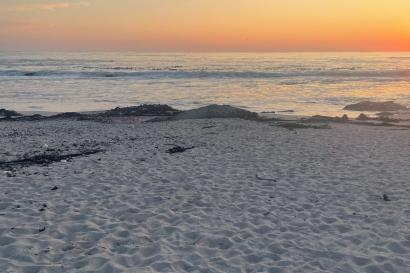I have been in Cape Town for about two weeks now, and I think I’ve started to get my footing here. It was definitely an adjustment at first, mostly with learning some new terminology, figuring out how to order at restaurants, and understanding the layout of the city, among others. The IES Abroad staff have been very helpful in providing tips on how to get around the city like a local and are amazing at suggesting things to do.
These adjustments all seemed like simple tasks, but something as easy as remembering to order tap water instead of just water to save a few rands is harder than it seems. I tried to learn some simple conversions before coming here, like how R100 is a little over US$7, and R500 is around US$35, and eventually, I’ve gotten to understand it from the casual everyday use. I would definitely recommend a money conversion app to anyone traveling to a new country. It’s super useful, but it does promote the fact that you are a tourist, so I’d say to restrict the use of it in public if possible (not that locals have any issue distinguishing what I have been told is, “That American twang”).
Most of the goods in South Africa are relatively cheaper than what one would pay in the U.S., so I’ve found myself being able to experience much more of the culture here than I would in America for the same price. I can consistently go out to restaurants and find full meals here for around R80-90 (i.e. $5-7), and there are pretty much always options for R60 (i.e. $4.23) or less.
Other than going out to eat, there are so many activities to do. I’ve really enjoyed the hiking that the city has available. Most people will travel to the trailhead by Uber, and splitting an XL ride among six people usually ends up at around a dollar a person. The three main mountains in Cape Town are Table Mountain, Lion’s Head, and Devil’s Peak. I plan to hike my way up each at least once, but I only have some experience with Table Mountain so far. One of the best things about this mountain is the insanely large number of trails available. Each trail can range from minutes to hours long, and they have varying levels of difficulty, making it a great mountain to hike for any skill level. I can’t make any real recommendations yet, but I know for sure that any one of them will be worth the view in the end. Ask any of the IES Abroad staff, professors, or locals for some of their favorites if you don't know where to start!
I think that a lot of my adjustment to this country was thanks to the Garden Route. Through this short three-day trip, I visited so many different places throughout the southern part of South Africa. I felt totally secure, as we had a few staff members come with, so if I ran into any issues, they could be sorted out. We went canoeing, hiked along the suspension bridge, walked hand-and-trunk with elephants, went spelunking, and hugged ostriches, all while staying in different cities and trying new food.
So far, it’s been pretty lekker, bru!

Payton Geschke
<p>From rummaging through my backyard as a little kid, to traversing through Starved Rock (Illinois) in high school, to a week-long hiking excursion in Zion National Park (Utah) and the Flatirons (Colorado) just this past spring break, I have always been an adventurer. I am a strong believer that getting out of one’s comfort zone and experiencing new things are critical aspects of creating a well-rounded and informed individual. I hope that as an IES correspondent, I will be able to share what I have gained from my experiences in a way that inspires others to put themselves out there.</p>








